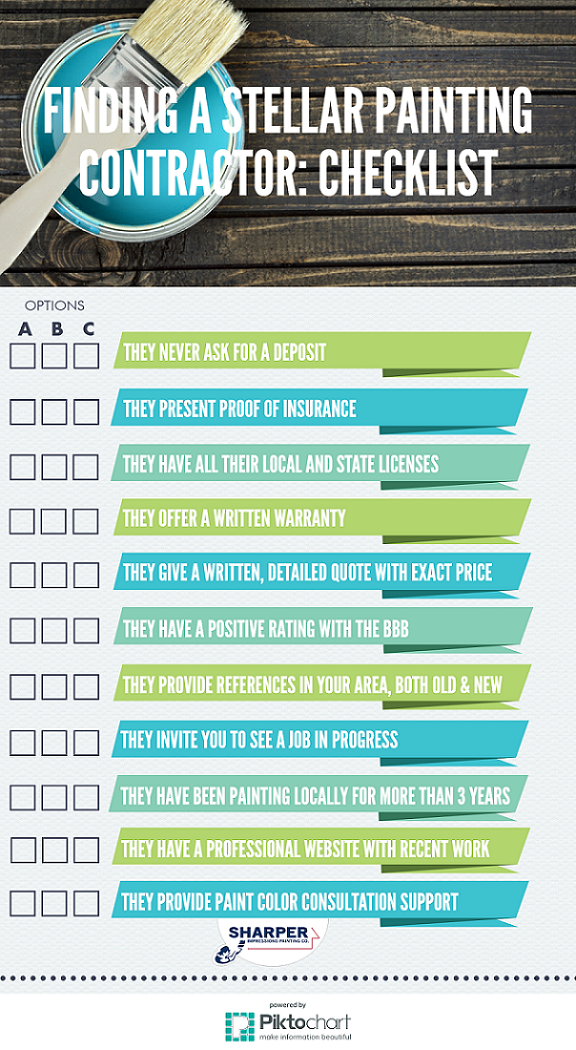Guaranteeing Your Wall Surfaces Are Well-Prepped For A Perfect Painting Task
Guaranteeing Your Wall Surfaces Are Well-Prepped For A Perfect Painting Task
Blog Article
Content Create By-Moses Christoffersen
Achieving a perfect paint task starts with precise wall surface prep work. From filling in flaws to priming surfaces, each step plays an essential role in the final end result. But what about those difficult edges and edges that can make or break the general look? Remain tuned to find professional ideas on how to browse these challenging areas with skill, guaranteeing a smooth finish that will raise your area to new heights of class.
Wall Surface Maintenance
Checking wall surfaces for any type of blemishes and promptly addressing them via needed repair work is critical for achieving a smooth and perfect paint work. Before beginning mouse click the following webpage , meticulously check out the wall surfaces for splits, holes, dents, or any other damages that can impact the result.
Start by completing any type of splits or openings with spackling compound, enabling it to completely dry completely before sanding it down to create a smooth surface area. For larger damages or harmed locations, consider making use of joint substance to guarantee a seamless repair.
Additionally, look for any kind of loosened paint or wallpaper that may need to be gotten rid of. Scrape off just click the following page of peeling paint or old wallpaper, and sand the surface area to produce a consistent structure.
It's also vital to inspect for water damages, as this can bring about mold and mildew growth and influence the adhesion of the brand-new paint. Deal with any type of water stains or mold with the appropriate cleaning solutions prior to waging the painting procedure.
Cleaning and Surface Area Prep Work
To guarantee an immaculate and well-prepared surface area for paint, the next action includes thoroughly cleaning and prepping the wall surfaces. Begin by cleaning https://caidenebxjs.shoutmyblog.com/33154853/are-you-prepared-to-uncover-expert-pointers-for-a-smooth-partnership-with-residence-painters-that-will-make-your-painting-job-a-trouble-free-experience with a microfiber fabric or a duster to remove any type of loose dirt, webs, or debris.
For more persistent dirt or gunk, a solution of mild cleaning agent and water can be made use of to carefully scrub the wall surfaces, followed by a thorough rinse with tidy water. Pay special interest to locations near light buttons, door deals with, and baseboards, as these often tend to gather more dust.
After cleaning, it is important to evaluate the wall surfaces for any cracks, openings, or blemishes. These ought to be loaded with spackling substance and sanded smooth when dry. Sanding the walls lightly with fine-grit sandpaper will additionally assist produce a consistent surface for paint.
Priming and Insulation
Before painting, the walls ought to be topped to make sure proper adhesion of the paint and taped to protect nearby surface areas from roaming brushstrokes. Priming acts as a vital action in the painting procedure, specifically for new drywall or surfaces that have been patched or repaired. It helps seal the wall surface, producing a smooth and uniform surface area for the paint to follow. Furthermore, primer can enhance the sturdiness and protection of the paint, inevitably leading to a much more specialist and durable coating.
When it pertains to taping, making use of painter's tape along trim, ceilings, and other surface areas you intend to protect is important to accomplish tidy and crisp paint lines. Painter's tape is designed to be conveniently used and gotten rid of without harming the underlying surface or leaving any residue. Put in the time to correctly tape off areas before painting to conserve on your own the headache of touch-ups in the future.
Final thought
To conclude, effectively preparing your wall surfaces before painting is vital for achieving a perfect finish. By inspecting for flaws, cleaning up extensively, keying the surface area, and using painter's tape for clean lines, you can make sure a professional-looking paint work.
Putting in the time to complete these steps will certainly result in a smooth and resilient surface that enhances the general look of your room.
